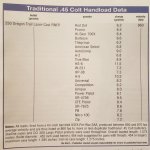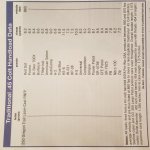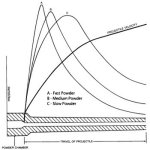This has been addressed several times in the past, but upon looking (again) at an article in "Handloader Magazine" from 2014, I realized that a chart they published illustrates the process well. The chart is for 45 Colt using 250 gr bullets and shows loads from 23 (!) powders that all produced an MV of 860 fps with those components in a certain gun, with a certain chronograph, with certain powder lots, etc. on that day.
Here's the chart:

Unfortunately, and for no apparent reason, the powders are listed in random order.
We learn two things from it:
1. relative Powder "Burn Rate"; and
2. relative Peak Pressures.
For example;
A. Red Dot, Titegroup, Competition, and Nitro all have the same approximate "Burn Rate" and will have the highest Peak Pressure;
B. HS-6 and A-5 have have the same approximate "Burn Rate" and will have the lowest Peak Pressure; and
C. AutoComp, True Blue, Unique and Power Pistol all have the same approximate "Burn Rate" and will have a Peak Pressure between the other two.
The results could be slightly different even on a different day, however, while some powders close to each other could well swap places, those on either end and in the middle are almost certain to remain there.
Assuming Group "A" is operating at the highest safe peak pressure, that means that you could load Groups B and C higher and achieve a higher MV while remaining at or below a safe operating pressure. This comes down to the pressure curve of powders with a slower burn rate having a wider curve plateau and more area under the pressure curve. For the most part all powders contain the same amount of energy per pound of powder, so if you can safely load more powder at the same pressure, more energy will be developed and hence a higher MV. A caveat is that the powder needs to be operating with the pressure range for which it was developed - 20.0 grs of US869 will probably not even ignite in the 45 Colt, so even 4.0 grs of Red Dot will beat it out every time.
Assume you did the test shown in the chart and you have a pistol powder for which no loads exist, from for example a lot of surplus powder. The more you know about it the better, for example that it was used in factory 45 ACP by the US Army. You can start by assuming that it has a burn rate that is very fast and load 3-4 rounds with 3.0, 4.0, 5.0 and 6.0 grs. Be careful with squib loads as you begin and if it happens, address it before moving higher. At some point you would reach the same MV as a known powder, for example if you had to go to 8.0 grs to achieve 860 fps, the powder is known to behave like Unique in your gun and as you develop loads with it in other chamberings, you can assume that it is slightly faster than Unique so as to build in a factor of safety.
Unlike the chart, you can use 3-4 powders to serve as reference points for the unknown powder.
A good example of this having been done on CGN is with the 8X63 Swedish powder that was once readily available. It was known that about 53.0 grs of that powder under a 218 gr bullet in an 8mm round with slightly more capacity than the 8mm-06 produced about 2500 fps, so the powder was known to have a Powder Burn Rate in the IMR-4064 to IMR-4350 range. So you would develop reference data in the round you want to use it in, say the 308 with a 180 gr bullet and using several powders in that range, e.g. using the same amount of powder (a near Max Published Load for fastest of them), in this example perhaps 40.0 grs of IMR-3031, 40.0 grs of IMR-4064, and 40.0 grs of IMR-4350 and chronograph them. Then fire 40.0 grs of the unknown powder with the same components - 308, 180 gr bullet, 40.0 grs of unknown powder. If its MV is slightly faster than IMR-4064, then it is a slightly faster powder than IMR-4064 and you would not load it as high as published IMR-4064 Load Data in the 308 with 180 gr bullets.
This is likely about as clear as mud for some people - I would be happy to clarify.
Here's the chart:

Unfortunately, and for no apparent reason, the powders are listed in random order.
We learn two things from it:
1. relative Powder "Burn Rate"; and
2. relative Peak Pressures.
For example;
A. Red Dot, Titegroup, Competition, and Nitro all have the same approximate "Burn Rate" and will have the highest Peak Pressure;
B. HS-6 and A-5 have have the same approximate "Burn Rate" and will have the lowest Peak Pressure; and
C. AutoComp, True Blue, Unique and Power Pistol all have the same approximate "Burn Rate" and will have a Peak Pressure between the other two.
The results could be slightly different even on a different day, however, while some powders close to each other could well swap places, those on either end and in the middle are almost certain to remain there.
Assuming Group "A" is operating at the highest safe peak pressure, that means that you could load Groups B and C higher and achieve a higher MV while remaining at or below a safe operating pressure. This comes down to the pressure curve of powders with a slower burn rate having a wider curve plateau and more area under the pressure curve. For the most part all powders contain the same amount of energy per pound of powder, so if you can safely load more powder at the same pressure, more energy will be developed and hence a higher MV. A caveat is that the powder needs to be operating with the pressure range for which it was developed - 20.0 grs of US869 will probably not even ignite in the 45 Colt, so even 4.0 grs of Red Dot will beat it out every time.
Assume you did the test shown in the chart and you have a pistol powder for which no loads exist, from for example a lot of surplus powder. The more you know about it the better, for example that it was used in factory 45 ACP by the US Army. You can start by assuming that it has a burn rate that is very fast and load 3-4 rounds with 3.0, 4.0, 5.0 and 6.0 grs. Be careful with squib loads as you begin and if it happens, address it before moving higher. At some point you would reach the same MV as a known powder, for example if you had to go to 8.0 grs to achieve 860 fps, the powder is known to behave like Unique in your gun and as you develop loads with it in other chamberings, you can assume that it is slightly faster than Unique so as to build in a factor of safety.
Unlike the chart, you can use 3-4 powders to serve as reference points for the unknown powder.
A good example of this having been done on CGN is with the 8X63 Swedish powder that was once readily available. It was known that about 53.0 grs of that powder under a 218 gr bullet in an 8mm round with slightly more capacity than the 8mm-06 produced about 2500 fps, so the powder was known to have a Powder Burn Rate in the IMR-4064 to IMR-4350 range. So you would develop reference data in the round you want to use it in, say the 308 with a 180 gr bullet and using several powders in that range, e.g. using the same amount of powder (a near Max Published Load for fastest of them), in this example perhaps 40.0 grs of IMR-3031, 40.0 grs of IMR-4064, and 40.0 grs of IMR-4350 and chronograph them. Then fire 40.0 grs of the unknown powder with the same components - 308, 180 gr bullet, 40.0 grs of unknown powder. If its MV is slightly faster than IMR-4064, then it is a slightly faster powder than IMR-4064 and you would not load it as high as published IMR-4064 Load Data in the 308 with 180 gr bullets.
This is likely about as clear as mud for some people - I would be happy to clarify.
Attachments
Last edited:












































































